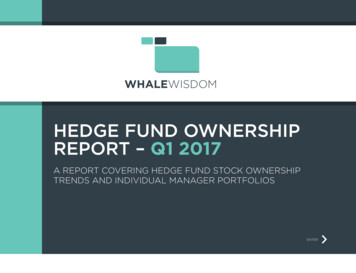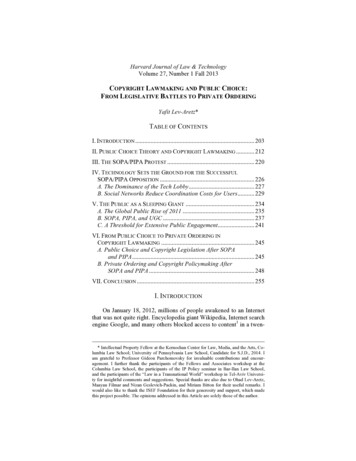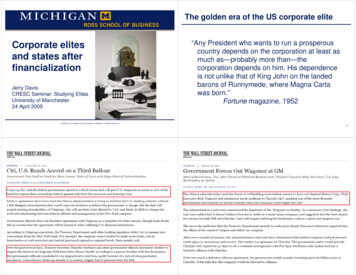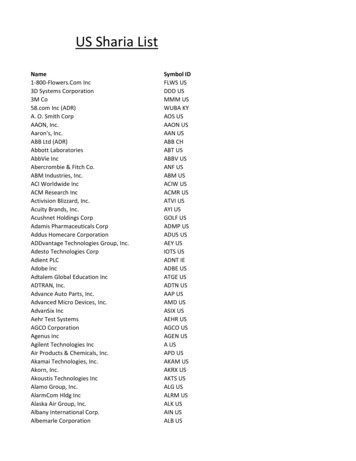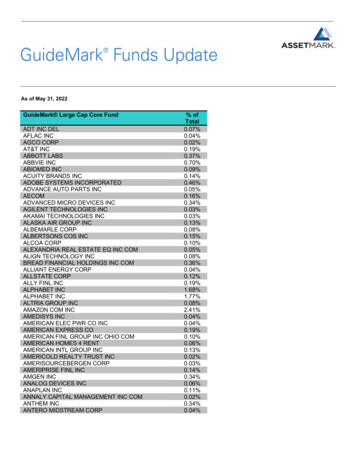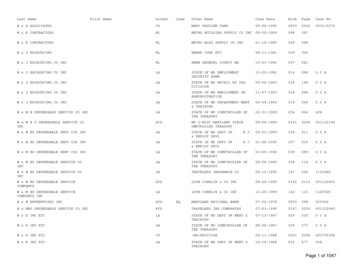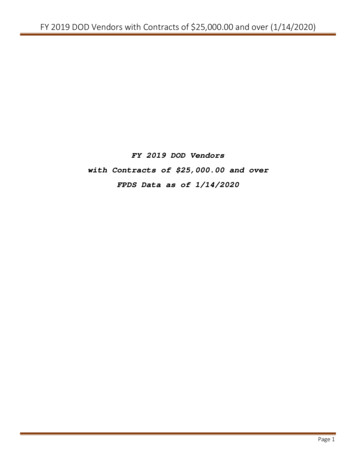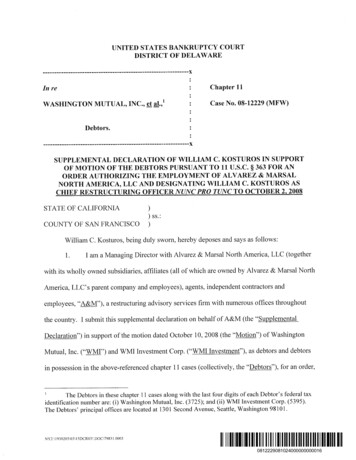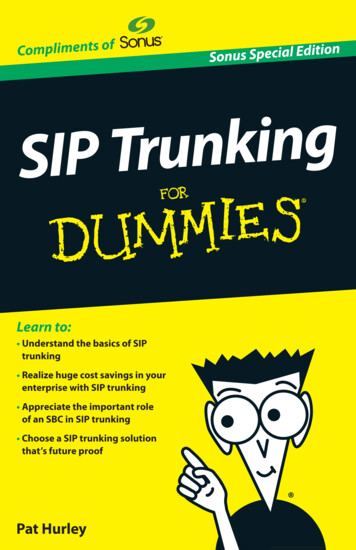
Transcription
Copyright myStockPlan.com Inc.Please do not distribute or copy without permission.Questions? Contact us at editors@mystockoptions.com
After reading thisoverview, see ourISO content sectionfor more detailedcoverage.
If your company orstock plan providerlicenses ourcontent, see theKnowledge Center.
An incentive stock option (ISO) is a specific type ofstock option that qualifies for special tax treatmentunder the Internal Revenue Code if the grant meetscertain requirements.ISOs are not granted by all companies and can begranted only to employees, not to outside directors,consultants, or contractors.There is a 100,000 limit on the aggregate grantvalue of ISOs that may first become exercisable (i.e.vest) in any calendar year.
After you exercise ISOs, if you hold the stock formore than two years from the date of grant andone year from the date of exercise, you receivefavorable long-term capital gains tax treatmentfor all appreciation over the exercise price.Failing to meet the ISO holding period results in a“disqualifying disposition”—i.e. the early saledisqualifies the ISOs from this special taxtreatment. In that case, they are taxed somewhat(but not exactly) like nonqualified stock options.ISO exercises can trigger the alternativeminimum tax (AMT).
In general, a stock option is a stockpurchase right a company grants to anindividual under the terms of a stockplan and grant agreement.You can exercise ISOs to buy a specificnumber of shares of company stock at aset price during a specified period.
ISOs cannot be exercised until the vesting periodprovided under the grant terms has elapsed.ISOs expire at the end of the term (e.g. ten years fromthe grant date) provided in the stock plan and grantagreement. After expiration, they cannot be exercised.Job termination stops vesting. Rules may vary in somesituations, such as death, disability, or retirement,depending on the specifics of your plan and grantagreement.To retain tax benefits, ISOs must be exercised withinthree months of the termination date.
After the vesting period has elapsed, youcan exercise the ISOs.To generate income at exercise, themarket price of the stock on the exercisedate must be higher than the exerciseprice of the ISOs.Exercise income is called “the spread.”
After acquiring company shares atexercise, you own them in the way ofany other shareholder. You can sell,gift, pledge, or hold the shares. When you sell the shares, the taxtreatment depends on how long youhave held the shares and on the stockprice at sale relative to the stock priceat exercise.
Typically, a vesting schedule is time-based: youmust work at the company for a certain periodbefore vesting.The schedule can also, or instead, beperformance-based or tied to company-specificor stock-market targets. (Not common withstock options.)Vesting schedules provide for either "cliff"vesting (the whole grant vests after youcomplete a stated service period) or "graded"vesting (e.g. 25% of the grant vests each year forfour years).
Cash Stock you already own (a stock swap) Cashless same-day sale Sell-to-cover exercise Promissory note Net options exercise
The simplest exercise method is the use ofcash to pay the exercise cost.Example: You have ISOs to purchase 100shares of your company's stock at an exerciseprice of 10 per share. When the stockreaches 15 per share, you exercise yourentire option using cash. To complete theexercise, you write a check to the company forthe exercise price of 1,000.
A cashless exercise is an exercise-and-sell transaction in whichyou do not have to supply the cash needed to pay the exerciseprice and the amount required for tax-withholding. Instead, yousimultaneously exercise your option and sell the stock. Example: You have 10,000 ISOs with a 15 exercise price. Youneed 150,000 for the exercise cost. The market price is 25,giving you a spread of 100,000 [( 25 - 15) x 10,000]. Proceeds needed from exercise and sale: 150,000 at exerciseto cover the exercise cost ( 150,000) paid to your company,and commission ( 500) for the stock sold. Proceeds from sale: 250,000 ( 25 x 10,000 shares). Proceeds you receive from cashless exercise: 100,000( 250,000 - 150,000). You pay taxes either with your annualreturn or throughquarterly estimated tax payments.
A sell-to-cover exercise is a type of cashless exercise in whichthe broker sells just enough of the shares from your exerciseto pay the exercise price, any tax withholding, and thebroker's transaction fees. You receive the remaining shares. Example: You have 10,000 ISOs with a 15 exercise price.You need 150,000 to cover the exercise cost. The marketprice is 25, giving you a spread of 100,000 [( 25 - 15) x10,000]. The brokerage commission is 500. Proceedsneeded at exercise: 150,500 at exercise to cover theexercise cost ( 150,000) and commission ( 500). Shares sold in sell-to-cover exercise: 6,020 ( 150,500divided by 25). Shares you keep from exercise: 3,980 (before subtractingany broker's fee for the transaction).
A stock swap, or stock-for-stock exercise, is astock option exercise in which the exercise priceis paid with shares of company stock you own.See the FAQ on stock swaps, as special issuesapply to ISOs.Some companies use a “net options” exercise, inwhich you return or surrender to the companysome of the stock options with a spread valuethat covers the total cost of exercising andholding. The number of shares you receive willequal the value of your exercise spread.
1.2.3.4.5.Hold shares two years from grant and one yearfrom exercise: full gain over exercise price atcapital gains rate. Qualifying disposition.If shares not held for that long, then spread atexercise is ordinary income, assuming stockprice increased. (When it has not, taxes vary.)No tax withholding or Social Security/Medicaretax, even upon early sale.If shares are held through the year of exercise,the spread at exercise is part of AMT income.AMT credit calculation in future years.
ISO taxation is complex. The tax impact depends on when yousell or transfer the stock.If you make a disqualifying disposition (e.g. sale or gift) of ISOshares, ordinary compensation income and any capitalgains/losses can vary according to the relationship between yourexercise price, the market price at exercise, and the sale price.With ISOs, you have no withholding at all, not even Social Securityor Medicare tax, at exercise or later sale.When you hold the shares long enough in a qualifyingdisposition, all the gain over the exercise price is capital gain.The spread on exercise of an ISO may trigger alternativeminimum tax (AMT) when you hold the stock through thecalendar year of exercise. AMT is a significant factor to considerin your tax planning for ISOs.
Example:Exercise 2,000 options with exercise price of 15when market price 20. Hold one year fromexercise/two from grant. Sell when price 20. 10,000 ( 5 x 2,000) in capital gain income(was also part of AMT income in year of exerciseand holding) 1500 in in federal capital gains tax (assume15%), plus state taxes. No Social Security, Medicare, or ordinary incometax.
1. Your sales price is lower than the market price on theexercise date (but is still above the exercise price). Theamount between the exercise price and the sales price iscompensation income. You have no capital gain or loss. Yourbasis equals your selling price.2. You sell at a price higher than the price of the shares onyour exercise date. The spread between the exercise priceand the stock price on the date of exercise is compensationincome. The sales amount over the exercise-day stock priceyou report as short-term capital gain.3. You sell the stock for less than your exercise price. Thecompensation income is zero. You also have a short-termcapital loss.
Example: Options at 15 per share you exercised thisyear when the market price was 55 per share. Youthought about selling the stock this year when theprice was 115, regret not selling it at 40, and nowdecide to sell it at 10. If you had sold at 115, you would have had 40 inordinary income ( 55 minus 15) and 60 in shortterm capital gain ( 115 minus 55). If you had sold at 40, you would have had 25 inordinary income ( 40 minus 15) and no capital gain. When you sell at 10, you have no ordinary income buta 5 short-term capital loss ( 10 minus 15).
The AMT system is complicated. Broadly, itstarts by taking your adjusted gross income,subtracts your itemized deductions, makescertain negative and positive adjustments,and includes certain tax items called tax"preferences." The resulting amount is your"alternative minimum taxable income" (AMTI).The spread at exercise of an ISO is a positiveadjustment for AMT purposes when youcontinue to hold the ISO stock through thecalendar year of exercise.
After AMTI is determined, it is reduced by anexemption amount. This AMT incomeexemption replaces the personal exemptionand standard deduction from the regular-taxsystem. It is indexed yearly for inflation.The AMTI exemption amount is phased outfor high-income individuals by 25 cents forevery dollar of AMTI over specifiedthresholds.See an FAQ for the specific current exemptionamounts and phasehout thresholds.
The net amount of AMTI is multiplied by the AMT rate toobtain the amount of AMT you owe. The rate is either26% or 28%, depending on the amount of AMTI.Alert: Don't be fooled if the AMT rates (26% and 28%) arelower than the rates of your regular tax bracket. YourAMT taxable income is often much higher because of thedifferences in how AMTI and regular taxable income arecalculated.Your effective AMT rate is higher if your exemptionamount is phased out.The calculations are further complicated if you had anycapital gains during the year, because capital gains aretaxed at 15% under AMT, not 26% or 28%.
For AMT purposes, you must always complete IRS Form6251 after you have exercised ISOs and held the sharesthrough calendar year of exercise (this is not reported onForm W-2).Once AMT is triggered, you must complete the formevery year, along with Form 8801, which relates to theAMT credit.You must file Form 8949 and Schedule D with yourfederal Form 1040 tax return for any tax year in whichyou have sold shares.Form 3921, which your company sends you in theJanuary after a year of ISO exercise, has information thatcan help you with the tax-return reporting.
In our Tax Center,detailed FAQs withannotated diagramsexplain all aspectsof ISO tax returnreporting.
ISO stock is dual-basis stock. Higher basis for AMTthan for ordinary income.Your gain or loss in the AMT system and the regulartax system will be different. Once you have sold thestock, avoid paying or calculating more AMT than isrequired for your ISO stock sale by reporting (as anegative amount) your adjusted gain or loss on line 17of IRS Form 6251.This negative adjustment can reduce the AMT youwould otherwise calculate and let you recover more ofyour AMT credit. The negative adjustment can't begreater than the capital gain for regular-tax purposesplus 3,000.
It can take years to benefit fully from the AMT credit if you areselling at a substantial loss. (Note that the former law providingfor refundable AMT credits has expired.)Standard use of AMT credit: In year when you do not trigger AMT,use credit against regular income tax up to amount of whatwould be your AMT. Does not require you sell the ISO stock.Example: Last year you paid 14,000 of AMT over your regular taxbecause of your ISO exercise and hold. This year, your regular tax is 35,000, while your AMTcalculation is only 30,000. 5,000 of the 14,000 credit is available, and you carryforward 9,000 to be used in future.
For details onthe AMT, seeour specialAMT sections.
A cashless exercise is an exercise-and-sell transaction in which you do not have to supply the cash needed to pay the exercise price and the amount required for tax-withholding. Instead, you . A stock swap, or stock-for-stock exercise, is a stock option exercise in which the exercise price
